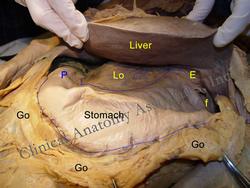|
UPDATED: The word [pylorus] is Greek. It arises from the word [πύλη] (p?li)meaning [gate]. In ancient Greek [πυλωρός] (pylorus) meant "gatekeeper" or "gate guard", leaving us to assume that Greek physicians had an idea of the function of the pylorus. The pylorus is a true anatomical sphincter and controls the emptying of the stomach. It is the most distal anatomical component of the stomach and can be see in the image marked with the letter "P". In history, it has been described by other names including "velut portanarium", and "pilorium" this last term was changed to "pylorus" by Andrea Vesalius. Using surface anatomy the location of the pylorus can be found on or slightly superior to the transpyloric plane and slightly to the right of the midline. |
 Go= Greater omentum, Lo=Lesser omentum, E= Esophagus, f=fundus, P= Pylorus. |
| Stenosis of the pylorus can lead to gastric emptying complications. A couple of surgical procedures to alleviate this condition are:
• Pyloromyotomy: From the root terms [pylor], meaning "pylorus", [-my-], meaning "muscle", and the suffix [-otomy], meaning "to open, or to cut"; therefore "opening of cutting the pyloric muscle" • Pyloroplasty: From the root terms [pylor], meaning "pylorus", and the suffix[-oplasty], meaning "to reshape or reconstruct"; therefore "pyloric reshaping".Images property of: CAA.Inc.. Photographer: D.M. Klein |
|
| MTD Main Page | Subscribe to MTD |